
From steam to punk and thereabouts
As time moves along, styles are becoming jumbled. The 1930s and Art-Deco have become something of a fixation, and for good reason (see below). Ingersoll is even gambling on a string of revived original Mickey Mouse watches mostly in quartz. And there are signs that the 70s and their horizontally rectangular television view of the world could be making a comeback.

Last year saw Hamilton’s re-release of a Pulsomatic, and the new-born 4N brand resorted to the great Renaud & Papi to implement an iconic “digital-looked” watch with an industrial price-tag.
But the persistent driving force behind design is mechanics. The internal combustion and steam engines are the source of inspiration for many brands. It all has to do with the fascination of reorganizing raw materials into a function whole, that warm and fuzzy feel of pistons sliding inside the oiled sheath of a motor block, the demented samba of the valves, the easy transfer of power from the wild explosion through the camshaft to the wheels that gives men, as a rule, the definitive feeling of once and for all overcoming their insignificance.

The success of such a simple esthetic strategy lies essentially in the level of separation between the metaphor and the message. Dozens of brands steer close to the source, like the German “airplane” watches Breitling and Fortis, or the less famous Meccaniche Veloci, from Smits Uurwerken, whose open plan booth flickered to a film of a motorbike racing around, over an over again, sounding like some demented bee caught inside a violin. The message has all the subtlety of an anvil falling on a bare toe. The watches are bold, round and with four subdials. One piece, in vermilion red, is made from a bike that has been dissected and whose remains stand in a corner of the booth for all to see. Is this piece of metal better than a newly machined bit of steel? And what fate befell that motorbike? No idea. Somewhere among the fluttering axons and dendrites is the lost message that a vehicle is a functional tool, but the rugged feel sparks the male id, no doubt.
(A footnote: There are other ways of expressing one’s disorganized personality or its opposite and nemesis. An example: the purity of a Nomos, which avoids the user needing to pull out an iPhone to tell the time. And besides, do I really want to have a spiritual whiff of Easy Rider on my arm, when CHF 25,000 or so will get a Romain Jeromethat includes a bit of the Eyjafjallajökull volcano – now there was shocker – or some rusted leftovers of the Titanic – a symbol of the world economy? – or even a bit of dinosaur feces? Tbd…..)
Pimped mechano sets
 A few steps up the sophistication scale are brands like Eberhardt, where the dashboard look seems almost incidental. Something about the asymmetry of the four subdials on the famous Chrono 4 series treats the eye and the mind to a little diversion. Many other brands have achieved some remarkable effects with the same idea, such as Chopard, which has integrated design elements recalling those bulky engines of the 30s. Armin Strom, too, besides revamping it
A few steps up the sophistication scale are brands like Eberhardt, where the dashboard look seems almost incidental. Something about the asymmetry of the four subdials on the famous Chrono 4 series treats the eye and the mind to a little diversion. Many other brands have achieved some remarkable effects with the same idea, such as Chopard, which has integrated design elements recalling those bulky engines of the 30s. Armin Strom, too, besides revamping it

s booth to make it a lot lighter, has developed a new collection, the Racing series, which is in sharp contrast to the Elements series. Two models are equipped with the in-house movement and are made of car parts as well. The dials range from straightforward to fairly complex, the Regulator consisting of interlocking subdials that give the sense of optical depth. Finally, a mention of the remarkable TAG Heuer Mikrotimer Flying 1000 Concept Chronograph, which measures 1000thof a second thanks to a special spiral, the absence of a balance wheel and a host of other patent-pending innovations. The brand pushes automobile names, like the Carrera, but what this has to do with the watch itself is anyone’s guess.
Engineer’s dream
For many brands, it is of course not about the cars but rather about the nostalgia of our dying world of mechanics, and here the automobile and plane references join a far larger archetype. Think Mazzuoli, who was not at Baselword, and his espresso machine pressure-gauge watches, or the Contagiri (rpm counter). Or the one-handed wonders of Meistersinger, extremely basic, and yet with lots of space to let the imagination wander, particularly back to simpler times. The watches of the small brand Ernst Benz might have been taken straight from the cockpit of an early model crop duster,and will therefore
harmonize well with muddy overalls or a casual three-piecer. The Michigan-based company’s latest idea is a tip of the hat to the old vinyl records industry, with concentric circles as a design element: just imagine a caveman faced with a jukebox playing Elvis in a greasy spoon outside Biloxi. Another Swiss-made American brand is Ball Watch– yes, it’s the origin of the expression to be “on the Ball” – A conscious effort has been made

to trace back to the birth of the watch in the high-employment
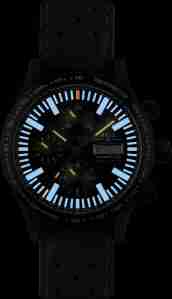
world of hogheads, bakeheads, yard rats and the other railroad denizen of the late 19th century, when people had their feet on the ground. The watches are all about functionality, including the use of tritium-filled vials to ensure lasting illumination in the dark.
Impossible to list all of the brands that pay homage to the age of real manufacturing, with metal parts and great wheels turning. Ultimately, however, that is the core beauty of a watch, the wheels, pivots and screws that reproduce the movement of the spheres in the galaxy. In his new X-Ray Series, Israeli horologist Itay Noy simply shows those inner workings of the timepiece on the dial as quasi-abstract element, one that suggests the workings inside. As a teacher of industrial design, Noy is educating a new generation of inventive designers, whose work is testimony to the limitlessness of the imagination when liberated from the illusion of market demand.
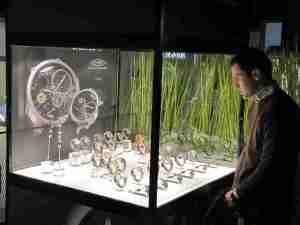

Other brands revert to Art Deco as the polite side of Chaplin’s Modern Times. The Twenty-8 Eight series of DeWitt is a superb example of the sheer timelessness, the industrial elegance of the 20s and 30s, be that the plain automatic in a chocolaty hue or the complex Tourbillon Regulator Horizons, with what seems like a homage to New York City. At the top of the gamme here, too, are the unique timepieces of Jean Dunand, and the Palace mentioned last year in this blog,the symphony of cylinders called the Shabaka, or the contrasting Tourbillon Orbital, a delight for those who enjoy top-drawer detail work and made-to-order individualism. Modern and playful, too, are the Perrelet turbines. The turbine itself no longer drives the automatic movement, since it had the drawback of acting as a brake, but it does produce a lively play of light and colour on the dial.

In the same vein are the outstanding pieces that need to be mentioned this year again: the fantastic – in the original sense of the word – Urwerk creations and the collective masterpieces organized by Max Büsser, which combine perfect craftsmanship, functionality and scintillating humour not often seen in the industry. And place must be made, too, for Hautlence’s HL2 collection, a mechanical tour de force with honeycomb dial, a jumping hour chain, various connecting rods like the eccentrics on a steam locomotive, and a particularly large crystal that allows a deep view into the mechanical pyrotechnics (see top of page). The watch comes straight out of an engineer’s LSD trip.
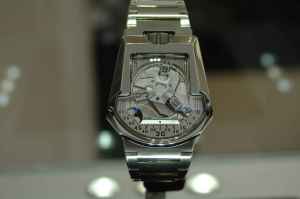

Finally, mention should be made of a brand that is nosing into this field, Ladoire. Last year, Lionel Ladoire’s colorful Mohican was probably more talked about than his massive platinum watch, which could easily serve as an arm weight for joggers (with CHF 108,000 plus to spare). A heavy off-rectangular frame surrounds a multi-dimensional dials that move, in part, around fixed hands. The movement is home-made. Buyers of the first editions could opt for an intricately machined titanium frame that lightened up the whole affair. Ladoire and his merry cohorts, who work in sophisticatedly trash offices in the Acacia industrial zone of Geneva have now come have toned down the steampunk look with the Black Widow series, lightened the watches and streamlined the face to make reading time a little easier. The turning dials are heavily painted with SuperLuminova, giving off an eerie glow in the dark. The price has been halved, but the customer can still have the watch customized, and by that Lionel Ladoire does not mean etching one’s favorite animal on the rotor.
The artists
One of the earliest steps in procreation is attraction, and that needs the wow. Nature has colorful feathers and great sexy manes for the male of the species, humans have the combined forces of Madison Avenue and “The Industry,” which manage to enliven the whole process of self-advertising for Him and Her alike. Creating colorful dials and strange shapes for watches is one possibility. But it only
works if it appears natural, otherwise a watch might have the same rhetorical vigor of an annual report in spite of the bells and whistles. Alain Silberstein, for example, continues to produce stunning objects with his daubs of color that either confront or enhance the severity of a timepiece, like the MB&F Horological Machine No. 2. Not far from his booth this year was Christophe Claret, who was presenting his third watch, the Blackjack. The name says it all: you can play blackjack with it, it even dings results. Roulette is played on the back, and craps in a lateral window. Though the theme is similar to Azimuth SP-1 Roulette, which was also on display, the style is very different.Chris Long and Alvin Lye push the envelope rather far out in their horological Träumerei. Their current creation is in the shape of a World War One tank, with the hours but definitely needs some tweaking to be more readable and perhaps a touch more elegant. For the moment it’s seems liable to tear off your cufflinks.
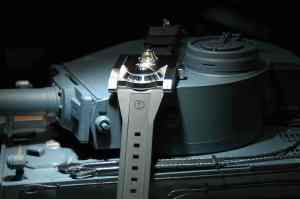
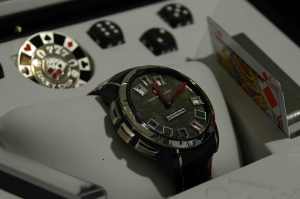
Primeval soup
As every year, many real cherries for any visitor to the fair were located up in Hall 5, the so-called Hall of Emotions, perhaps the most appropriately named. It is here that I returned to Thomas Prescher, who is involved in the Promethean task of getting his Mysterious Tourbillon to work properly while surviving on a his outstanding record of special concepts. Rebuilding older watches for customer is the bread and butter of his business, and a few of those were on display.Two independents have also emerged who caught my eye.

The first is Marc Jenni with his JJJ, a tribute to a distant relative in the past, the 18th-century watchmaker Johann Jakob Jenny. The watch features a large lateral winding crown and some surprising display elements, such as a window giving the ancient – Roman – daily planets, the moon for Monday, Mars for Tuesday, and so forth. The other buzz is about the One Hertz by the Grönefelds, two Dutch brothers from a family of watchmakers, who have turned time on its head with a large subdial featuring deadbeat seconds driven by their own movement, and hours and minutes in a smaller subdial at 2 o’clock. At first glance, this is a minimalist’s dream, but slowly the different layers of the watch face and indicators begin to interweave and the beauty and balance of the piece hits home, like the alcohol concealed in the easy fruitiness of a thirst-quenching cocktail.

Eastern winds
This all too brief review of the Baselworld 2011 closes with mention of two remarkable young watchmakers from the east. The first is the Hungarian Aaron Becsei, whose Dignitas collection seems inspired by architectural historicism.
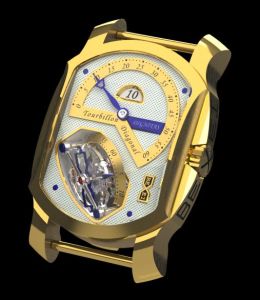
His timepieces surprise with odd outbursts, like a slanted tourbillon carrying a seconds indicator that seems to have landed in the watch face like a ninja star, retrograde minutes in a frame with a curiously angled foot and jumping hours. Here is a watchmaker of extreme skill, who obviously has the courage to break out new ideas and then put in the days, months, even years to see them to fruition.
Becsei’s collections include intricate table clocks as well, with tourbillons and eclectic decorative elements. Not unlike his neighbor at the AHCI booth, Konstantin Chaykin, a thin, intense Russian autodidact with a track record of particularly complex timepieces. Last year he displayed an intricate table clock with a complication showing the Orthodox Easter, another with a Muslim calendar, and a watch with ancient Jewish time in the back (see…). This year, he brought the Lunakhod, a masterstroke made of, among others, Wootz – a very special early steel alloy known inIndia over 2000 years ago – with a harmoniously integrated gray band. The watch has a could blend into the pebbles on a beach. With his sister, Nadja, interpreting, he explains that we always see the same side of the moon, so a moon phase with a turning moon is not really authentic. There in the middle of the dial is a 3D moon. The phases are shown by the shadow slowly folding over it, a neat and well executed complication. Another little detail is the semicircular display for the hours, which is not retrograde: p.m. is shown by a moon at the tip of the hour hand, a.m. by a little sun. The seconds are in a subdial. And the dark side of the moon is in the back where it belongs. Altogether Dostoyevskian in its duality. And a stroke of genius in the overall concept.


